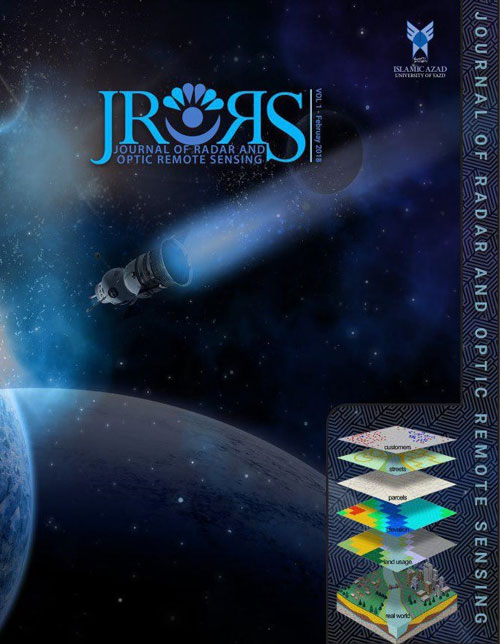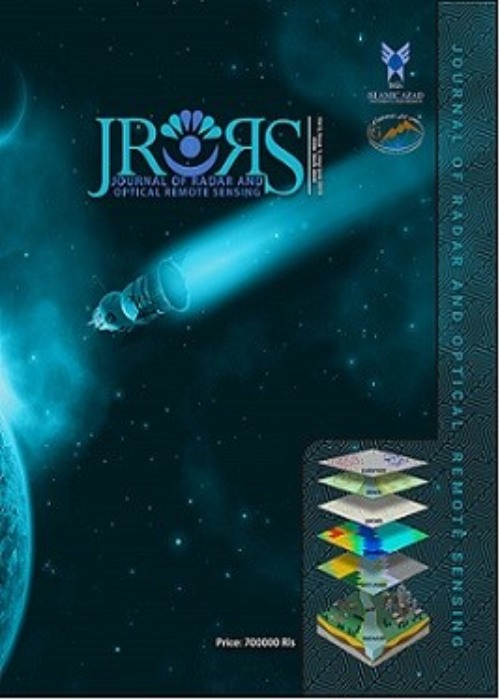فهرست مطالب

Journal of Radar and Optical Remote Sensing
Volume:1 Issue: 1, Spring 2018
- تاریخ انتشار: 1396/12/12
- تعداد عناوین: 6
-
Pages 7-14Active structures have an important role in controlling fluvial systems through longitudinal and lateral tilting. The Ghezel Ozan River in northwest of Iran has responded to ongoing tectonic deformation in the basin. The study area is located in the Western Alborz zone and includes part of the Ghezel Ozan River. This paper presents the role of active structures in making active deformations via detection and characterization of fluvial anomalies and correlation with structures. The study area is characterized by association of fluvial anomalies viz. deflection, anomalous sinuosity variations and knick point in longitudinal profile. Such fluvial anomalies have been identified on the repetitive satellite images and maps and interpreted through DEM and field observations to identify active structures in the area. Some of the structures in the study area have caused the fluvial anomalies and the most active structures are surface and sub-surface faults and folds with trend of NE-SW.Keywords: Active structures, Ghezel Ozan River, Fluvial anomalies
-
Pages 15-35The urban thermal island phenomenon has intensified in recent years due to the changes in urban airspace along with the rise of urbanization. Spatial-temporal patterns of biophysical constituents, which include vegetation, impermeable surfaces and soil type in the city, have a significant impact on urban thermal islands. The purpose of this study is to investigate the role of effective urban parameters in the formation and clustering of Yazd urban thermal islands. In order to achieve the proposed goal, the thermal map was developed using the single-window algorithm on the thermal band of OLT sensor of Landsat ETM+ sensors for August, 2015 and 2017; Land surface temperature (LST) was calculated and using spatial correlation (LISA), hot and cold clusters of thermal islands of Yazd were extracted. In order to evaluate the surface temperature, with the intensity of LST, spatial heterogeneity of the clusters increases nonlinearly. The relationship between the thermal islands with NDVI and urban carrion layers were investigated. Cold clusters are around the places with more green space and hot clusters are in the arid areas and in areas without vegetation cover. The result of the correlation between the surface temperature and the NDVI, NDBI, and NDBaI indicated that the relationship between NDVI and LST is negative, and the relationship between NDBaI and LST is also nonlinear and negative. But the relationship between NDBI and LST is nonlinear and positive. A spatial correlation with the local index has emphasized the extent of thermal islands in the studied periodsKeywords: Urban thermal islands, Ahwaz City, Local spatial correlation index (LISA)
-
Pages 36-57Fuzzy classification techniques have been developed recently to estimate the class composition of image pixels, but their output provides no indication of how these classes are distributed spatially within the instantaneous field of view represented by the pixel. Super-resolution land-cover mapping is a promising technology for prediction of the spatial distribution of each land-cover class at the sub-pixel scale. This distribution is often determined based on the principle of spatial dependence and from land-cover fraction images derived with soft classification technology. As such, while the accuracy of land cover target identification has been improved using fuzzy classification, it remains for robust techniques that provide better spatial representation of land cover to be developed. An approach was adopted that used the output from a fuzzy classification to constrain a Hopfield neural network formulated as an energy minimization tool. The network converges to a minimum of an energy function. This energy minimum represents a “best guess” map of the spatial distribution of class components in each pixel. The technique was applied to remote sensing imagery (MODIS & OLI images), and the resultant maps provided an accurate and improved representation of the land covers. Low RMSE, high accuracy. By using a Hopfield neural network, more accurate measures of land cover targets can be obtained, The Hopfield neural network used in this way represents a simple, robust, and efficient technique, and results suggest that it is a useful tool for identifying land cover targets from remotely sensed imagery at the sub-pixel scale. The present research purpose was evaluation of HNN algorithm efficiency for different land covers (Land, Water, Agriculture land and Vegetation) through Area Error Proportion, RMSE and Correlation coefficient parameters on MODIS & OLI images and related ranking, results of present super resolution algorithm has shown that according to precedence, most improvement in feature’s recognition happened for Water, Land, Agriculture land and ad last Vegetation with RMSEs 0.044, 0.072, 0.1 and 0.108.Keywords: Fuzzy classification, Hopfield Neural Network, Spatial resolution, Subpixel, land cover, Energy function, Super resolution
-
Pages 58-67Vegetation Indices (VIs) obtained from remote sensing (RS) based canopies are quite simple and effective algorithms for quantitative and qualitative evaluations of vegetation cover, vigor, and growth dynamics, among other applications .In the study for modeling and estimated of density and percentage vegetation value of Artemisia Herba alba was used Green Difference Vegetation Index (GDVI), Normalized Difference Vegetation Index (NDVI), Optimized Soil Adjusted Vegetation Index (OSAVI), Soil Adjusted Vegetation Index (SAVI) by Landsat 8 ETM+ bands vegetation in the Fathabad of Darab plain, Iran in 2015 years. By software ENVI preprocessing, processing, geometric and atmospheric corrections were performed, and then vegetation index for the study area was calculated. Also ArcGIS 10.2 software for mapping of area vegetation was applied. Then relationship between Vegetation Indices and density and vegetation value of Artemisia herba alba was determined. The results show that with increasing of percentage and density of vegetation, the value of vegetation indices increase. Finally, in order to determination of suitable elevation of growing of Artemisia herba alba was determined relationship between elevation and percentage of vegetation. The results show that the best elevation for growing of Artemisia herba alba was 1767 to 1782..Keywords: Vegetation Indices (VIs), Remote sensing (RS), Artemisia herba alba
-
Pages 68-82In recent decades, rapid and incorrect changes in land use have been associated with consequences such as natural resources degradation and environmental pollution. Detecting land use changes is a suitable technique for natural resource management. The goal of this research is to study the land use change in Haraz Basin with an area of 677000 hectares in 15 years (1996 & 2011) using Landsat data. After making the necessary corrections and preparing the indices, the image classification into nine classes was by supervised classification and Maximum Likelihood algorithm. Finally, the changes were extracted by Post classification comparison. The results showed that during the 15 years there was a 27.5% change in land use of the area. These changes are related to conversion of rangelands to bare lands and dry farming ones; and also converting the dense forest to sparse forest, horticulture, farming lands, and residential areas. These changes can be due to an increase in population and human activities, which result in increasing demands for natural sources and converting them into farming lands, horticulture, residential and industrial areas. These land use changes along with climate changes are an alarm for the Haraz Basin status in the future.Keywords: change detection, Haraz Basin, Land use, Remote Sensing
-
Pages 83-96Remote sensing is a useful technology as a superior to other methods thanks to features like vast and integrated view of the area, repeatability, accessibility and high precision of information, and saving in time. Vegetation index is extensively used nowadays in different continental, regional, and areal scales. Due to excessive use of natural resources, area of landscapes has been changing day to day and updating of the maps is a costly and time-consuming task. Thus, many of the well-developed countries take benefit of satellite data at different levels. The analysed factors included 1- preparation of vegetation and land use maps of North Khuzestan; 2- assessment of biological potential in agriculture development of the studied area using WLC and weighted overlay technique. Based on the acquired results and performed computations, it was demonstrated the variations in the pasture and agriculture soil during the years from 2003 to 2014 were 19 percent and a significant reduction is observed in this part of land use. The changes between the years 2014 to 2016 were equal to approximately 11 percent according to the computations. This value is remarkably high and indicates intensity of changes during the recent years.Keywords: Remote Sensing, Land sat Images, Vegetation, Agriculture Development


